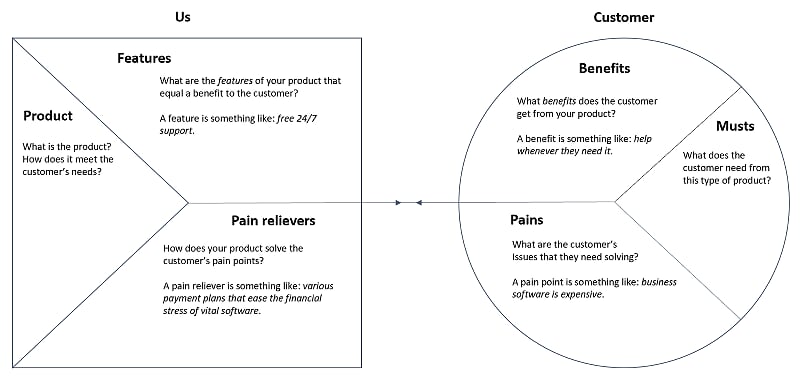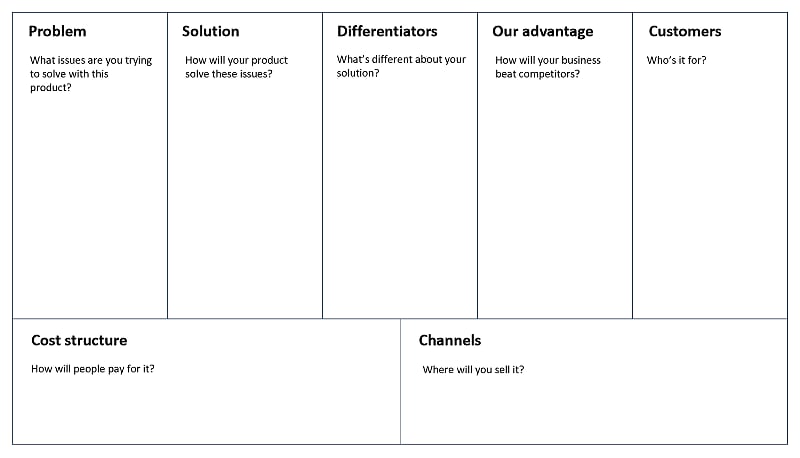
You’ve got an idea for a new product. Brilliant.
But to develop that idea into a tangible thing, you need to write a product proposition.
Not only does this let other people understand your proposal; it also gets your own thinking clear about how it will work, how you’ll market it and whether it’s different enough for you to have an advantage over competitors.
Using product proposition tools to check your market fit
There are lots of ways to map out your product proposition, and I find that I generally adapt existing models for my own preferences.
1. Value Proposition Canvas
The first product proposition tool I use is the Value Proposition Canvas, designed by Dr Alexander Osterwalder.
It’s a diagram you fill in to make sure you’re balancing your customer needs with your product outline, your customer pain points with your pain reducers and your customer benefits with your product features. This is your market fit, and all of those points need to match up for you to have a viable proposition.
I’ve adapted mine a little from the original proposition canvas, and I’ve added some explanations to help you fill yours out.

2. Lean Canvas
Lean Canvas is a very clear and simple way of getting your proposition straight. It’s far easier to present to other people than a great big essay on your product.
Again, I adapt this canvas (to be even simpler!) and my example explains what each section should hold.

I use these two product proposition tools together, as it helps me check I’ve got all angles covered.
That’s the high-level planning done – now we can fill in the blanks for ourselves. No one wants to read an essay, but I find it helps to have a written-out proposal.
How to write your product proposition
1. Audience profile
Who is the product for?
List your ideal customers: ages, needs, locations and how they buy.
Graduates under 25 looking for their first real job – they’re digital, internet-based and prefer subscriptions.
2. Marketing
Where and how will you sell the product?
Direct – through your own website, wherever that’s directed from.
Channel sales – Amazon, eBay and so on.
3. Product offering
What is the technical outline of the product?
Lay out how it works behind the scenes, what the key features are, whether it’s an annual contract, subscription or one-off purchase and any restrictions.
4. Customer benefits
What are the customer benefits, rather than just the features?
Think back to your audiences – what are their pain points. If your features solve those pains, like in our canvases above, you have a balanced product.
5. Payment collection
How will your customers pay for your product?
One-off card payment, ongoing monthly direct debit, monthly bank charge, annual charge, deposit and credit plan?
Think about all the payment options available now. Can you afford to offer PayPal, Apple Pay and Google Pay? Would Klarna (paying in three or delaying payment) work for this product?
6. Customer relationship
How will you talk to your customers? How would THEY choose to hear from you?
Will you provide value-add content? How will customers receive it?
Customer pitch
You should now be able to write up the story of your product. You know what you’re offering – how do you relay that to customers?
This doesn’t have to be exactly how you market it, but it should get you close to how you’d introduce your product to the world.
Step Accounting is for anyone who dreads that tax return deadline. Save time with automated tools and get 24/7 chat support from professional accountants. Take control of your business accounts for a fee worked out from your turnover. You grow, we grow.
These canvases help you get to your product proposition, they help others come along for the ride and they help you start to work out what the story is for your audience.






